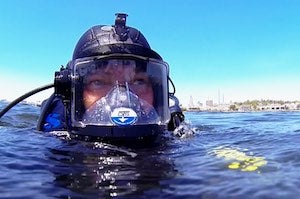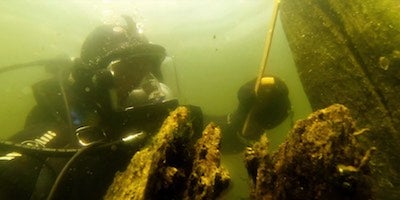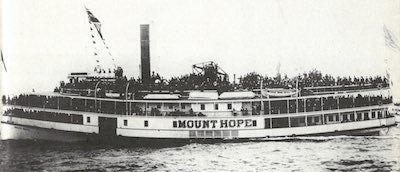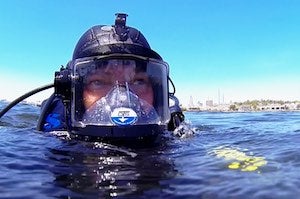 NARRAGANSETT, R.I. — March 4, 2016 — Zipping down I-95 in Providence, they’re hard to miss: wood and pilings poking through the Providence River like the tree trunks of a forgotten forest.
NARRAGANSETT, R.I. — March 4, 2016 — Zipping down I-95 in Providence, they’re hard to miss: wood and pilings poking through the Providence River like the tree trunks of a forgotten forest.
That debris has turned into a treasure, thanks to David Robinson, a University of Rhode Island marine archaeologist who has discovered the largest ship graveyard in the state, with the remains of more than two dozen old vessels from long ago.
The vessels from the mid-19th century to early-20th century that spread across 33 acres of Green Jacket Shoal off Bold Point in Providence Harbor include five steamboats, six sailing ships and 15 barges—all proof of Providence’s past role as a maritime powerhouse. Robinson is mapping and researching the site in a study for federal, state and local agencies.
Two of his more amazing finds are the Mount Hope and Bay Queen, both iconic paddle-wheel steamships from the 1800s that conjure images of Rhode Islanders on sweltering summer days a century ago, cruising Narragansett Bay on their way to feast on clams and watermelons at a shore dinner hall—perhaps Rocky Point or Crescent Park. For now, however, they molder on the riverbottom, a treat for Robinson’s eyes only—at least for now.
“The site is a cultural landscape with rare physical evidence of Providence’s heyday as a maritime hub and industrial port that served as a link between Boston and New York,” says Robinson. “It’s a unique site that is extraordinarily visible and accessible to the public. More than 100,000 cars a day drive by the site, which amounts to tens of millions a year. That’s incredible.”
Robinson will give a free talk about his research on Thursday, March 17 from 4 to 6 p.m. at the Coastal Institute Auditorium, 218 South Ferry Road, at URI’s Graduate School of Oceanography in Narragansett. Guests can expect to see photos of Robinson’s work and also videos he’s taken of the vessels, most of which are in remarkably good shape.
These days, underwater archaeologists are taking more notice of ship graveyards ever since Congress passed a law transferring the titles for abandoned ships in state waters to the states to prevent vandalism and looting. In fact, the URI talk will also include a presentation by Susan Langley, underwater archaeologist for Maryland, who will discuss the Mallows Bay site—the largest ship graveyard in the western hemisphere with the remains of more than 100 World War I-era wooden steamboats.
Although the “Providence Harbor Ship Graveyard” has been there for more than a century, officials only recently decided to do something about it.
In 2013, Rhode Island Sea Grant funded URI oceanographers John King and Monique LaFrance Bartley to survey, with sonar equipment, the shallow waters off Bold Point Park. They recorded a variety of debris and a handful of ships—or so they thought at the time. Robinson joined the project to find out if the ships had any historical significance.
“My job was to figure out if there was anything that might be historically important,” he says, “or if the wreckage was just an accumulation of modern barges and other random junk.”
 First, he did his homework on shore, poring over documents and old newspapers in city archives, libraries and historical groups. What he discovered piqued his interest even more: Bold Point had once hosted the Providence Dry Dock & Marine Railway Company, a shipyard that repaired and maintained vessels in the late 1800s and early 1900s. Its floating dry dock was the first on Narragansett Bay and was used, along with two marine railways, to haul ships out of the water for repairs and service.
First, he did his homework on shore, poring over documents and old newspapers in city archives, libraries and historical groups. What he discovered piqued his interest even more: Bold Point had once hosted the Providence Dry Dock & Marine Railway Company, a shipyard that repaired and maintained vessels in the late 1800s and early 1900s. Its floating dry dock was the first on Narragansett Bay and was used, along with two marine railways, to haul ships out of the water for repairs and service.
The vessels off Bold Point, Robinson concluded, were abandoned there “at the end of their working lives.” Many were likely transported to the company’s yard from within Providence Harbor, stripped of their valuable machinery and hardware—engines, boilers, paddle wheels, whistles, clocks, navigational instruments, rigging gear, bells, chairs and even chandeliers—and then moved a short distance to Green Jacket Shoal to rest in peace.
“The landscape at Bold Point was industrial in nature back then,” says Robinson. “Green Jacket Shoal was outside of the dredged harbor limits and its navigation channel, and the ship graveyard was away from slips, piers, businesses and homes along the Providence waterfront. It was a convenient location to dispose of vessels whose careers had run their course.”
 After cracking the books, Robinson dived in—literally. In his underwater explorations last April and May and with aerial photographs from a drone, that handful of ship remains turned into 26 vessels, including the hardy Mount Hope and Bay Queen, illustrative of the glory days of Rhode Island’s regular and excursion steamboat lines.
After cracking the books, Robinson dived in—literally. In his underwater explorations last April and May and with aerial photographs from a drone, that handful of ship remains turned into 26 vessels, including the hardy Mount Hope and Bay Queen, illustrative of the glory days of Rhode Island’s regular and excursion steamboat lines.
At the end of the 19th century into the early 20th century—before cars clogged the roadways—Rhode Islanders eager to escape the heat took all-day cruises on the steamships, stopping at cavernous shore dinner halls at Crescent Park, Prudence Park, Conanicut Park, Newport and Narragansett Pier for chowder, clam cakes, steamed clams and watermelon.
“The ship graveyard site has a direct connection to our state’s rich maritime past—and the water,” he says. “These steamships were part of the fabric of Rhode Island. When people were on these vessels, they were there to have a good time.”
Two hundred feet long, with the capacity to hold up to 3,000 people, the boats could reach speeds of up to 18 miles per hour, which, back then, was plenty fast. Captains, crunched up in tiny pilot houses, competed against each other, sometimes playing “chicken” racing back to shore.
“They didn’t have to wait for the wind. These captains went,” says Robinson. “Many steamboat lines were in stiff competition with one another, competing for passengers. One way to get passengers was to go exceptionally fast. These captains were real personalities. Total characters.”
Once Robinson finishes his research, he’ll send his report to Rhode Island Sea Grant, which will pass along his findings to the Coastal Resources Management Council, Rhode Island Historical and Heritage Preservation Commission, local communities and other agencies. Together, they’ll decide what to do with the graveyard: Leave it alone or remove the ships—or a combination of both.
Removing, preserving and exhibiting the vessels on shore would be costly, Robinson says. They would also have to be treated with special chemicals to keep them from decomposing and, once stabilized, stored in a proper facility.
Robinson has a better idea: Leave the vessels undisturbed and create ways for the public to enjoy them, maybe through a website with maps, photos, videos, three-dimensional models of the shipwrecks and historical tidbits.
“You could go out there in your kayak, pull out your cell phone and see 3D models of the shipwrecks that lie beneath you,” he says. “In that way, we could invite the public to interact with the site in a way that is safe and imaginative.”
The mystery of underwater archaeology has always intrigued Robinson.
Growing up in Narragansett, he explored the ocean with a diving mask before he knew how to swim. Diving is a family tradition. His great-uncle, Thomas Eadie, of Newport, was among the first U.S. Navy divers and received a Congressional Medal of Honor for saving the life of a fellow diver during a submarine salvage operation in the 1920s. Robinson’s father, Stewart Robinson, also of Newport, was a commercial diver in the 1950s and 1960s who helped construct the underwater portions of the Claiborne Pell Bridge, among other projects. He also was a salvage diver and blew up sunken vessels for scrap metal—an irony that does not escape his son.
“He blew up shipwrecks, and I’m trying to save them,” Robinson says.
Robinson made his first dives when he was 15, including one off Bonnet Point to glimpse the wreck of the 1872 sidewheel steamboat, Rhode Island. He even mapped and researched the shipwreck for a 10th grade American history project.
He graduated from URI in 1990 with a dual degree in art and anthropology and then got his master’s degree in anthropology—specializing in shipwreck archaeology—from Texas A&M University. From there, he found work as an underwater archaeologist working for museums and cultural management firms in Vermont, Maryland and, finally, back home in Rhode Island.
In 2012, Robinson joined URI to team up with GSO’s King to work on a study with the Narragansett Indian Tribal Historic Preservation Office. Funded by the U.S. Department of the Interior’s Bureau of Ocean Energy Management, the team is developing “best practice” protocols for identifying and protecting ancient Native American cultural sites preserved on the ocean floor. Known as drowned sites, these areas were submerged by rising sea levels over the last 16,000 years.
The graveyard project seemed like a perfect fit for the 51-year-old Jamestown resident. Not only is he collaborating again with King, he’s working with his two oldest sons, also professional divers trained in underwater archaeology: Michael, a 2013 URI graduate, and Noah, a student at Rhode Island College. Robinson’s lifelong friends and childhood diving companions, Peter Manning and Glenn Anderson, are helping him explore the murky waters of the graveyard as well.
“I’m getting to do what I enjoyed doing as a kid and with the same people I was with then, as well as family and colleagues,” says Robinson. “It seems like life has come full circle. I’m lucky to have a career that allows me to do what I like best—research and explore history underwater and share my interest and knowledge about the past. It’s a great life.”
His talk is part of the annual Coastal State Discussion Series. RSVP is requested by contacting Meredith Haas at mmhaas@uri.edu or visiting http://seagrant.gso.uri.edu/special-programs/coastal-state-discussion-series/

The series is sponsored by Rhode Island Sea Grant with the support of GSO, URI’s Coastal Institute and the College of the Environment and Life Sciences.
Pictured above:

